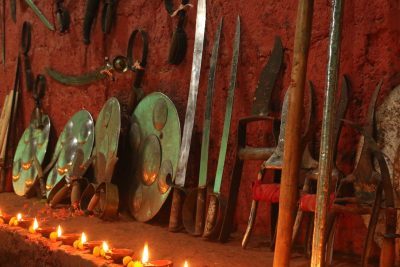
KALARIPAYATTU WEAPONS: AN OVERVIEW
The use of weapons is integral to kalaripayattu and one of the more unusual aspects of the art, with some weapons that are used nowhere else, such as the otta (curved wooden weapon) and urumi (flexible sword). In kalaripayattu there are four general stages of practice that students must become proficient in before becoming a master: Meythari, Kolthari, Ankathari and Verumkai. The two middle practices, Kolthari and Ankathari, involve the use of different types of weapons. Kolthari is the practice of wooden weapons, and Ankathari is the practice of metal weapons.
KALARIPAYATTU WEAPON SKILLS
It takes many years of regular and dedicated practice to develop the necessary skills to properly wield the many kalaripayattu weapons. Weapons are intended to become an extension of the body, to be used fluidly and skilfully in different fighting contexts. According to kalaripayattu, there are only five parts of the human body that can be properly attacked with weapons when the base protective stance, or amarcha, is engaged. These five parts are; oathiram (head), olavu (both sides of face), poravu (between shoulder and elbow), katakam (below the knees), and vaari (sides of the body on the ribcage). Attack and defence moves and sequences are centred around these five parts.
The primary physical skills to be acquired by the kalari fighter are likened to the qualities of Indian animals: simhasya garjanam, to have the roar of a lion, vygrasya sikram, to have the speed of a leopard, and marjara lagavam, to have the flexibility or agility of a cat, to be able to always on four feet and step silently.
Practicing with kalaripayattu weapons also has many benefits and develops superior reflex and focus skills, as intense and constant concentration on the enemy’s movements is necessary to avoid harm. The main mental skills are considered to be deep concentration (ekageratha), willpower (ichashakti), and self-confidence (atmavisvasa). There is a saying in kalari that ‘the whole body becomes an eye’, mey kannakuka, meaning to have such highly developed senses and skills that a fighter can become acutely aware of their environment, and assess and act with an intuitive clarity. With regular and continuous weapons practice, these skills increase and the fighter can achieve this heightened state of awareness.
Another aspect of the focus necessary for weapons practice is that it is like meditation: it trains the strength of the mind. Distraction is to be avoided at all costs as it could be fatal. This means that a regular practice of kalaripayattu weapons will give similar benefits to a regular meditation practice for ordinary people, such as mindfulness, clarity, and a greater ability to focus.
TYPES OF KALARIPAYATTU WEAPONS
Kalaripayattu weapons can be broadly split into two sections, Muktham and Amuktham. Amuktham are weapons that remain in the hand and are not thrown, which includes almost all the weapons of Kolthari and Ankathari, and most of the weapons that are used today. Muktham covers those weapons that are thrown by hand, such as the spear, bow and arrow and the cakra. The cakra is a metal disc that has an orbicular blade that is thrown (maiming or decapitating its target on the way) and returns to the wielder by means of a rope held in the hand. The spear belongs to both groups.
Weapons are all measured according to the ancient Indian measuring system, of fingerwidths (angulam), handspans (chan), and feet (adi: equal to 24 angulam).
KOLTHARI (WOODEN WEAPONS)
The second stage of kalaripayattu and the first stage of weapon practice is called Kolthari, the practice of wooden weapons. Each new weapon is introduced at the Gurukkal’s discretion, and are listed here in order of teaching.
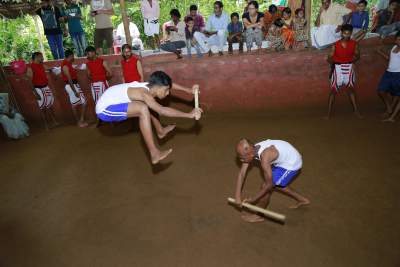
Muchan (short stick, sometimes called cheruvadi)
The first weapon is called muchan, the short stick, which is three chan, or handspans, in length. Muchan literally means ‘three handspans’, and cheruvadi means ‘short stick’. It is used for fast attacks and defence. Speed is very important for muchan, and 200 blows per minute may be exchanged during a muchan fight. The muchan needs to be very strong, and should therefore be made of wild wood, normally from kaara (Eleocarpus serratus) or from the cultivated woods of coffee (Malayalam: kaapi) or tamarind (Malayalam:pulli). Mainly one muchan is used, but two can also be used by more advanced practitioners. Iratta muchan is double muchan practice. Muchan is also the only weapon used in the lion fighting form.
Kettu kaari (long stick)
After the muchan, students progress to the kettu kaari, a longer, thinner weapon, normally made of bamboo or cane. The stick should be the length of the gurukkal’s eyelevel, regardless of student height. The rotational force produced makes this weapon formidable and its length provides a safer distance from the opponent. Both sides of the stick are used equally, for a balanced attack and defence; when faced with a kettu kaari expert, the enemy should never know which end of the stick is going to attack. Practice with this weapon will allow greater proficiency in the spear, which is introduced in Ankathari.

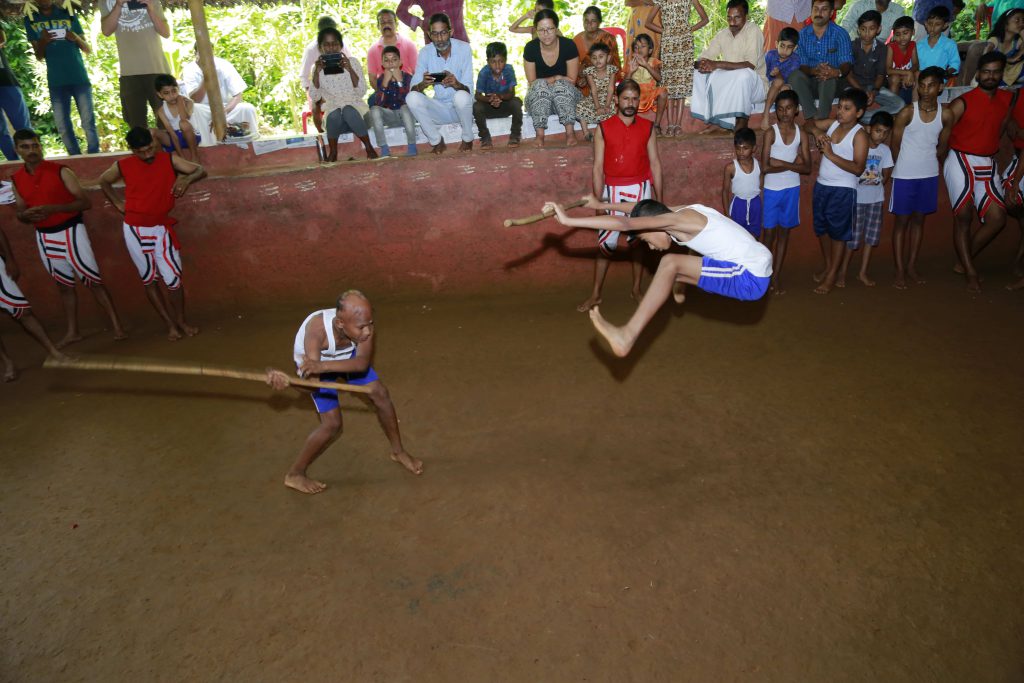
Pandiraan veeshel (extra long stick)
This weapon is 12 handspans longer, it should be a little longer than the kettu kaari. This weapon is used to fight a group of enemies, as it can cover the whole surrounding area for defence. It uses very fast movements and contrary to the kettu kaari, only one end is used, which is what allows for a larger area for defence. Experts of this weapon can make it move so fast that you can hear the air breaking.
Otta (curved weapon)
One of the most unusual weapons of kalaripayattu, the Otta is long and curved with a handle at one end and a small club at the other. It is meant to honor the powerful trunk of an elephant, which was used so skillfully in combat with a lion as observed by Lord Shiva himself. Because of this, the otta is used in the elephant fighting form, the only weapon to do so. This weapon also includes marma attack, meaning it attacks certain vital points on the body to overcome the enemy. Marma points are only known by masters and senior students. This is a very advanced weapon and requires great skill and mental fortitude to master. There is a kalari proverb: ‘He who is an expert of otta can not be touched even in sleep’. Marma are only taught to students after 12 years practice, which traditionally meant this weapon could also only be learned after 12 years, even after the learning of the Ankathari weapons, which are the third step of training after Kolthari. However, the moves of the otta are more commonly taught today at earlier stages of practice. This is the final wooden weapon to be learnt by students.

ANKATHARI (METAL WEAPONS)
All the Ankathari weapons are made from steel, and sometimes different materials are used for the handles, such as brass or copper. In ancient times, Ayurvedic herbs were used during the forging process in order to imbue extraordinary strength and special qualities into the metal – it is said they could break rocks.

Kathi (knives)
The first of the metal weapons to be taught are the kathi. Kathi training can use many different types of knives, and two can be used at once, one in each hand. Many types of knives exist, and what is used depends on availability. Some of the common ones used are kaimarakathi (handled knife) and irettakathi (double-sided knife), both of which are used at Kadathanadan Kalari. After the kathi have been mastered, students will gain more confidence in fighting, and will be able to gauge the enemy’s hand movements more instinctively.The first of the metal weapons to be taught are the kathi. Kathi training can use many different types of knives, and two can be used at once, one in each hand. Many types of knives exist, and what is used depends on availability. Some of the common ones used are kaimarakathi (handled knife) and irettakathi (double-sided knife), both of which are used at Kadathanadan Kalari. After the kathi have been mastered, students will gain more confidence in fighting, and will be able to gauge the enemy’s hand movements more instinctively.
Kathiyum thalayum (knives and long cloth)
The thala is a piece of cloth traditionally worn in Kerala, usually as a belt but also slung over the shoulders or on the head. It was used in ancient times until about 100 years ago, and it not commonly used now except for some elderly people in village areas. The thala is mainly used in knife and barehanded combat, and is effective for blocking, and for tying up the enemy in a variety of ways and throwing them. Sometimes they would even tie up the enemy’s whole body so they would be fully bound! The thala was very useful for warriors to use when they could not take weapons with them, such as to marriage functions, or if they were disarmed, they would still have this somewhat disguised weapon. The use of the thala was also widely known by ordinary people, as it was a piece of the normal dress and hence could be adopted easily.


Kadara (dagger)
Kadara is only used for one-handed fighting. Length is normally six angulam, or finger-lengths. Kathi and kadara are taught as necessary precursors before Verumkai (barehanded fighting) can be learnt. It includes different types of blocks, locks, grappling, jumps, dives and throws. As a very small weapon, the fighter needs to be very close to the enemy, and this requires attention, physical strength and agility. Because of this, this is one of the weapons where focus and concentration is required the most.
Valum Parijaim (sword and shield)
Valum parijaim was the traditional set of weapons used in the battlefield. The best length for the val (sword) is 40 angulam (fingerwidths), approximately 70cm/2½ feet. The main fighting form used for valum parijaim is puliyangam, or large cat form (the word puli is used to denote tiger, panther and leopard in Malayalam interchangeably). Puliyangam is a combination of different types of sword swings and attacks, and defence with the shield, an imitation of the attack method of the puli. Practice of this weapon trains the fighter to become used to the sound of metal weapons clashing, and they will lose their fear and reaction to these sounds.
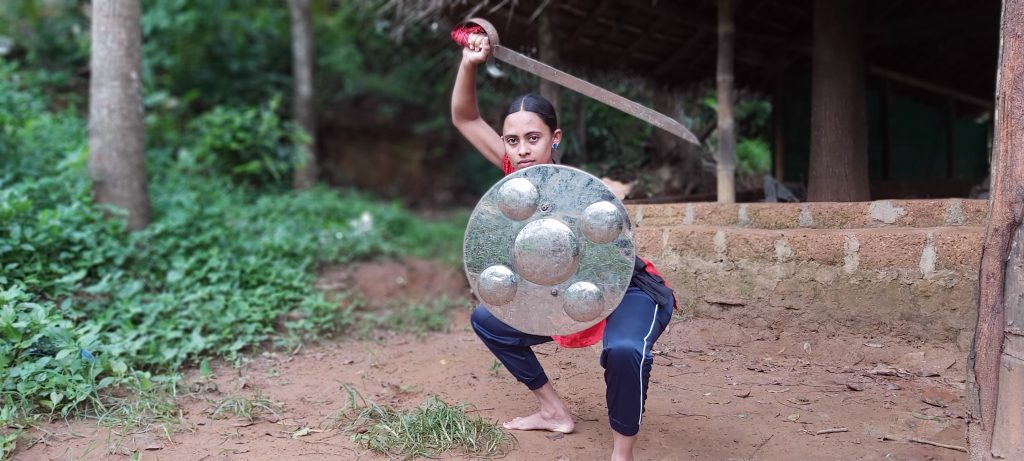

Urumi (long flexible sword)
A famously lethal weapon, the urumi is one of the most deadly of the Ankathari. Both sides of the urumi are sharp, the metal is thin, strong and pliant, and the length is normally the same height as a human (the Gurukkal is normally used for height when making). Because of the flexible nature and long length of this weapon, it has great range and agility, and in the hands of an expert, it is said to be able to slice an enemy into seven pieces. For the same reasons, it also requires a huge amount of skill on the part of the fighter to not hit themselves.
It works on different types of rotation and can move very fast, making a terrifying metal song, and is known for being invisible, a detail no doubt noticed by anyone who has observed it in full force. In an open field, the urumi will stir up dust from the ground as the rotations hit the earth, and make the fighters invisible. It is one of the best weapons for fighting against groups and several opponents can be quickly decapitated. Because it is flexible, the urumi can be also used as a belt, which means it is easy to move and travel with, and to disguise. In modern times, the urumi used in kalaripayattu is not sharp, though it can still be dangerous.
Marapidicha kundam (spear and sword)
The marapidicha kundam is the one of the most dangerous combinations of kalaripayattu weapons, and is the most advanced. The kundam (spear) is of human height (normally the gurukkal’s height), made from wood with a metal spearhead on the end, normally about 1-1½ feet/30-40cm long. The sword is the same sword and shield as described in valum parijaim. The combination of spear and sword is not used in any other traditional Indian martial art form, only in kalaripayattu (for example, you may find sword on sword or spear on spear in other areas, but not spear on sword). In kalaripayattu, two kundam cannot be used to fight against each other. The kundam is used in the lion fighting form as is the muchan, and is the only weapon to be used in the snake fighting form.
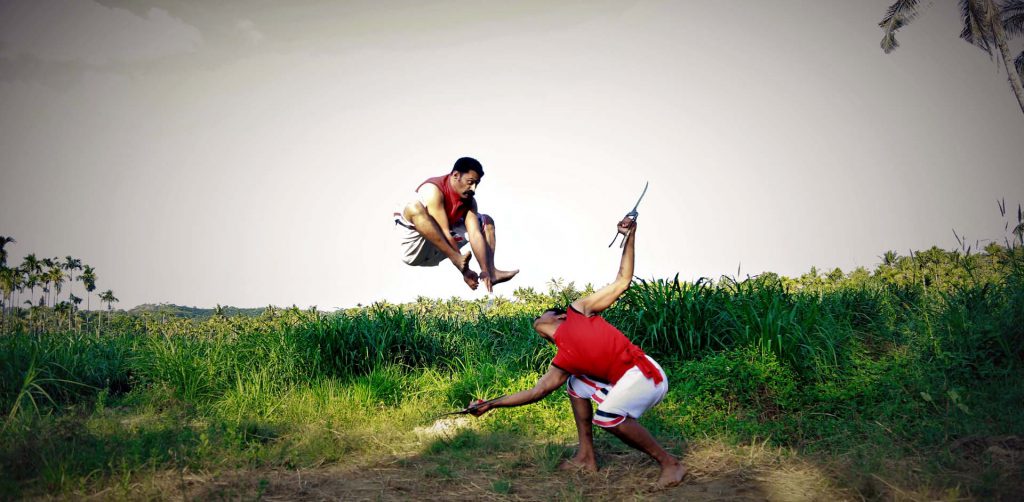
*It is worth noting that each Gurukkal is different and will have their own methods and sequences for teaching, and this information is specific to the method taught at the Kadathanadan Sangam.
**English translations of Malayalam words may vary.


No Comments
Sorry, the comment form is closed at this time.